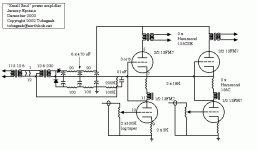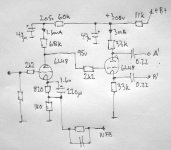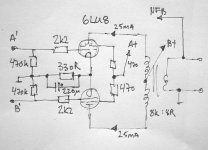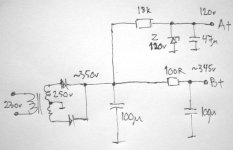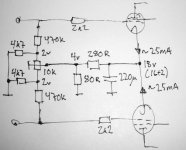Has anyone played around with vertical deflection tubes (6LU8, 6LR8, 6KY8, triode with power pentode) for audio purposes?
A pair of 6LU8 looks promising in a small push pull setup: you'll get 2 high mu triodes, one for input stage and one for phase splitter (split load) and two beam pentodes with Pa of 14w each. Looks like a better candidate in terms of power than in example ECL86 and friends.
But I cant find much information on the net using those kind of tube for audio -- any obvious pitfalls using them?
A pair of 6LU8 looks promising in a small push pull setup: you'll get 2 high mu triodes, one for input stage and one for phase splitter (split load) and two beam pentodes with Pa of 14w each. Looks like a better candidate in terms of power than in example ECL86 and friends.
But I cant find much information on the net using those kind of tube for audio -- any obvious pitfalls using them?
Y'mean dissimilar dual triodes? Those have been used ('GF7, et al), something like a watt or two SE from line level in one bottle.
Vertical deflection tubes are nothing new. I made a 6W6 PP amp (not something I hear much about, it has ample current- if you find them cheap, buy many!), 6V6 is even rated for vert deflection. 6S4, like a few 6C4 rolled into one, is 0.5-1W IIRC. Better as a chunky driver.
6LU8 looks like a 12AT7, er, 6AB4 rolled with a chunkier 6V6, well 6W6 would be better to say given the higher perveance. You should be able to do 2.5-5W, up to 20W PP (near class B) with it. High voltages aren't required, you could get respectable output from a mere 150V B+.
6LR8 appears to be exactly the same, with a more convienient base.
6KY8 is very similar, slightly less perveance and power and a smaller triode.
Tim
Vertical deflection tubes are nothing new. I made a 6W6 PP amp (not something I hear much about, it has ample current- if you find them cheap, buy many!), 6V6 is even rated for vert deflection. 6S4, like a few 6C4 rolled into one, is 0.5-1W IIRC. Better as a chunky driver.
6LU8 looks like a 12AT7, er, 6AB4 rolled with a chunkier 6V6, well 6W6 would be better to say given the higher perveance. You should be able to do 2.5-5W, up to 20W PP (near class B) with it. High voltages aren't required, you could get respectable output from a mere 150V B+.
6LR8 appears to be exactly the same, with a more convienient base.
6KY8 is very similar, slightly less perveance and power and a smaller triode.
Tim
I hate to say this, because $5 NOS tubes will become $300 Collectables, but.....
> vertical deflection tubes ... for audio purposes?
Vertical deflection amplifiers ARE audio amplifiers. You have a 60Hz fundamental with overtones past 17KHz, a couple watts of energy sloshing into a reactive load of a few ohms, and a fairly high standard of linearity.
And the economic pressures forced "simple" systems, which is also good for audio (fewer high-order nonlinearities).
> any obvious pitfalls using them?
Your snooty golden-ear friends will sneer at mere TV tubes.
> 6V6 is even rated for vert deflection
Yes, though it isn't very good for the job. I think it was a stop-gap when TV sets moved from long-neck to shorter CRTs with wider deflection. The large twin-triodes were no longer enough. 6V6 was in every TV development workbench stock-room. It was big enough. It was VERY available for production because it had been very popular and was going out of style in audio duty.
A simple robust amplifier favors a triode. If the Mu is less than 5 or 4, you can't drive it with an R-C coupled driver eating the same B+; if Mu is higher than necessary then plate resistance goes up, you lose power and damping. This is what led to types 45, 50, 300, and the workhorse 2A3.
It takes more work to make a pentode amp "good", but you can get a lot more rated watts per dollar. So commercial production audio moved to pentodes.
TV economics hide the V-sweep costs behind the H-sweep. The H-sweep handles 10 to 40 watts of energy, the V-sweep just a couple. I have never seen a triode H-sweep: the least inefficiency swamps you in cost and weight and heat. But after slaving over the H-sweep stage, for a long time designers stuck with simple triode V-sweeps. They work good, without fuss, and the small inefficiency is lost in overall power consumption.
What they really wanted was a big 50 or a small 2A3, but both types were going out of production. There was the 6B4 which was a 6V 2A3. Of course a modern unipotential-cathode 2A3 would be sweeter. 12B4 is a half-size unipotential-cathode 2A3/6B4 with a little more Mu dialed-in, and promoted "primarily for service as a vertical-deflection amplifier in television receivers". Good, but why have just one tube per bottle, especially when a V-sweep circuit is 2 tubes? And when you start pinching pennies, that Mu=6.5 and Rp=1030Ω is a bit high. And as TVs got bigger in the face and shallower to the wall, 5 watt dissipation was not enough.
My personal fav is 6EM7. Small side is a lot like 12AT7, an under-appreciated tube. Big-side is shockingly like a 2A3, but with convenient unipotential-cathode. Easy half-watt loafing, a watt or two easy, maybe a bit more slammed to the ratings(*). All in one bottle. Push-pull it isn't far short of a pair of 2A3, which was a status-symbol in the days when triodes were kings of audio. Two bottles is a complete amp. Parallel 4 or 8 bottle, get Power, and lash-up complicated drive schemes.
6EM7 stands out because the small side is hi-Mu, the big side has a lovely low Mu. A V-sweep amp needs a total Mu of about 300. An audio amp needs about the same. There were several dual-triodes that split it as 20*15, but low-Mu in the power stage means more power and damping. The 6EM7's big side is as big as any other. It also was, for good reason, very common, meaning there are heaps of leftover 6EM7 around at good prices.
You can follow the foolish path to Pentodes, as TV designers did when cost-cutting became cut-throat. There are some interesting triode-powerpentode bottles. And because this was the last generation of tube TV, and tubes suit TV well, some of those types stayed in irregular production all through the dark decades. If the triode Mu is around 5, it may be a decent audio triode. However, making a pentode V-sweep meant gimmicking-up the simple designs to get linear sweep, so some of these pentodes are naturally nonlinear and will show large 2nd harmonic.
(*) The TV-service ratings are sometimes conservative. TV tubes swing so hard that a small component shift or tuning-drift may cause a large increase in dissipation. In some cases, it looks like TV ratings are de-rated, in self-defense against sloppy production tolerances. You can probably lean hard on the ratings, as long as you measure and KNOW your actual dissipation.
> vertical deflection tubes ... for audio purposes?
Vertical deflection amplifiers ARE audio amplifiers. You have a 60Hz fundamental with overtones past 17KHz, a couple watts of energy sloshing into a reactive load of a few ohms, and a fairly high standard of linearity.
And the economic pressures forced "simple" systems, which is also good for audio (fewer high-order nonlinearities).
> any obvious pitfalls using them?
Your snooty golden-ear friends will sneer at mere TV tubes.
> 6V6 is even rated for vert deflection
Yes, though it isn't very good for the job. I think it was a stop-gap when TV sets moved from long-neck to shorter CRTs with wider deflection. The large twin-triodes were no longer enough. 6V6 was in every TV development workbench stock-room. It was big enough. It was VERY available for production because it had been very popular and was going out of style in audio duty.
A simple robust amplifier favors a triode. If the Mu is less than 5 or 4, you can't drive it with an R-C coupled driver eating the same B+; if Mu is higher than necessary then plate resistance goes up, you lose power and damping. This is what led to types 45, 50, 300, and the workhorse 2A3.
It takes more work to make a pentode amp "good", but you can get a lot more rated watts per dollar. So commercial production audio moved to pentodes.
TV economics hide the V-sweep costs behind the H-sweep. The H-sweep handles 10 to 40 watts of energy, the V-sweep just a couple. I have never seen a triode H-sweep: the least inefficiency swamps you in cost and weight and heat. But after slaving over the H-sweep stage, for a long time designers stuck with simple triode V-sweeps. They work good, without fuss, and the small inefficiency is lost in overall power consumption.
What they really wanted was a big 50 or a small 2A3, but both types were going out of production. There was the 6B4 which was a 6V 2A3. Of course a modern unipotential-cathode 2A3 would be sweeter. 12B4 is a half-size unipotential-cathode 2A3/6B4 with a little more Mu dialed-in, and promoted "primarily for service as a vertical-deflection amplifier in television receivers". Good, but why have just one tube per bottle, especially when a V-sweep circuit is 2 tubes? And when you start pinching pennies, that Mu=6.5 and Rp=1030Ω is a bit high. And as TVs got bigger in the face and shallower to the wall, 5 watt dissipation was not enough.
My personal fav is 6EM7. Small side is a lot like 12AT7, an under-appreciated tube. Big-side is shockingly like a 2A3, but with convenient unipotential-cathode. Easy half-watt loafing, a watt or two easy, maybe a bit more slammed to the ratings(*). All in one bottle. Push-pull it isn't far short of a pair of 2A3, which was a status-symbol in the days when triodes were kings of audio. Two bottles is a complete amp. Parallel 4 or 8 bottle, get Power, and lash-up complicated drive schemes.
6EM7 stands out because the small side is hi-Mu, the big side has a lovely low Mu. A V-sweep amp needs a total Mu of about 300. An audio amp needs about the same. There were several dual-triodes that split it as 20*15, but low-Mu in the power stage means more power and damping. The 6EM7's big side is as big as any other. It also was, for good reason, very common, meaning there are heaps of leftover 6EM7 around at good prices.
You can follow the foolish path to Pentodes, as TV designers did when cost-cutting became cut-throat. There are some interesting triode-powerpentode bottles. And because this was the last generation of tube TV, and tubes suit TV well, some of those types stayed in irregular production all through the dark decades. If the triode Mu is around 5, it may be a decent audio triode. However, making a pentode V-sweep meant gimmicking-up the simple designs to get linear sweep, so some of these pentodes are naturally nonlinear and will show large 2nd harmonic.
(*) The TV-service ratings are sometimes conservative. TV tubes swing so hard that a small component shift or tuning-drift may cause a large increase in dissipation. In some cases, it looks like TV ratings are de-rated, in self-defense against sloppy production tolerances. You can probably lean hard on the ratings, as long as you measure and KNOW your actual dissipation.
PRR said:(*) The TV-service ratings are sometimes conservative. TV tubes swing so hard that a small component shift or tuning-drift may cause a large increase in dissipation. In some cases, it looks like TV ratings are de-rated, in self-defense against sloppy production tolerances. You can probably lean hard on the ratings, as long as you measure and KNOW your actual dissipation. [/B]
I must confess that I have never seen a European TV that used a triode for vertical deflection (but then, I may be too young, or lived in a place where early TVs were just far too expensive). ELC/PCL82 is the norm here, and later PCL85/805.
However, the interesting one is the rare PL508. The reason i am mentioning it is PRRs post about conservative specs on TV tubes. The PL508 must be the beefyest 12W Pdiss pentode out there
Looking at the curves, G2 drive seems feasible (a pair PCL82 or 84 as drivers?). I have not been able to find triode connected curves for this tube... Any insight, PRR?
> PL508 must be the beefiest 12W Pdiss pentode out there
At 6 watts heater power and 300V-400V plate, it should be between 6V6 and 6L6 for total power handling. So yeah, it is conservative, but some of the H-sweep tubes are even more so.
> [/i]triode connected curves[/i]
You can make some guesses from the sheet. Gm is about 9,000uMho and Mu is 8, so Rp is around 888 ohms. There is a graph for G1=~0V at various G2 voltages, you can plot the triode zero-bias line which limits your Class A swing. (The actual triode curve will be a little to the left of this for voltages below ~100V: the shelf in the plate line suggests that G2 is sucking big current at low plate voltages. In triode the G2 current adds to the plate current.) On the graph for G2=200V, read up the Vp=200V line abd read the G1 voltage for various currents, you get a clue to grid bias and swing. That's enough to rough-compare it to other tubes, and to breadboard something that will work.
At 6 watts heater power and 300V-400V plate, it should be between 6V6 and 6L6 for total power handling. So yeah, it is conservative, but some of the H-sweep tubes are even more so.
> [/i]triode connected curves[/i]
You can make some guesses from the sheet. Gm is about 9,000uMho and Mu is 8, so Rp is around 888 ohms. There is a graph for G1=~0V at various G2 voltages, you can plot the triode zero-bias line which limits your Class A swing. (The actual triode curve will be a little to the left of this for voltages below ~100V: the shelf in the plate line suggests that G2 is sucking big current at low plate voltages. In triode the G2 current adds to the plate current.) On the graph for G2=200V, read up the Vp=200V line abd read the G1 voltage for various currents, you get a clue to grid bias and swing. That's enough to rough-compare it to other tubes, and to breadboard something that will work.
EL/PL500, EL/PL504, EL/PL508, EL/PL509, EL/PL519 power pentodes are useable in audio technology. for example EL509 PP-amp was in production here, by an acoustical company. they giving 100W, after 30 years too... with the original tubes.
they are so cheap tubes. for example the PL500 here costs 2 Euro. socket is available too. yeah, and an ECF802 costs 50 Eurocents, 0,5 Euro. it's so good for pre-stage (pentode part of 802) and cathodyne phase splitter.
lot of diyer says, the TV-tubes are not good for audio, and they can't sound good. I don't agree with them! (OK, a PL500 amp won't be sounding so nice as a 2A3 amp... but they are really cheap, and easy to buy!)
so everybody let's bulid a simple and extremely cheap ECF802+EL500 PP amp!
(oh, my bad english... sorry, folks)
they are so cheap tubes. for example the PL500 here costs 2 Euro. socket is available too. yeah, and an ECF802 costs 50 Eurocents, 0,5 Euro. it's so good for pre-stage (pentode part of 802) and cathodyne phase splitter.
lot of diyer says, the TV-tubes are not good for audio, and they can't sound good. I don't agree with them! (OK, a PL500 amp won't be sounding so nice as a 2A3 amp... but they are really cheap, and easy to buy!)
so everybody let's bulid a simple and extremely cheap ECF802+EL500 PP amp!
(oh, my bad english... sorry, folks)
Which reminds me, I have 6 x 'LQ6's, though one has a poopy cathode (heat sensitive: nil emission at 5V, moderate at 6V, good at 7-8V). But I was going to use those, or the quad 30DK6s, for a tube induction heater. Man, why is it I have to wind an OPT wherever I go... at least that one only has to handle 10kHz...
Tim
Tim
edl said:EL/PL500, EL/PL504, EL/PL508, EL/PL509, EL/PL519 power pentodes are useable in audio technology. for example EL509 PP-amp was in production here, by an acoustical company. they giving 100W, after 30 years too... with the original tubes.
The KT90 is the recent sibling from the PL500 line out TV class....so many todays tubes are derivatives from those oldies. Even 807's.
I've used the PL series with top caps for audio.....most give high Pout but at higher thd than tubes specifically designed for audio. These tubes weren't designed for UL operation.....unless someone knows better.
Substit KT90 in lieu of KT88's will give roughly double the thd for the same circuit but +10% more poke. MI great.
Caveat emptor.
richj
I once built a small audio amp using one 6KY8 triode/power pentode tube. Worked pretty well. It won the "uglyest audio amp" award on rec.audio.tubes some time ago.  Ugly construction but sounded good. I usually enclose my amps inside rectangular boxes instead of the wood sided chassis with tubes and transformers sticking out up top style.
Ugly construction but sounded good. I usually enclose my amps inside rectangular boxes instead of the wood sided chassis with tubes and transformers sticking out up top style.
richwalters said:
The KT90 is the recent sibling from the PL500 line out TV class....
I've seen a reference to the KT90 being a 'repackaged PL519'. Is there any truth to that claim?
Regarding PL508, the thing I like about them is the absence of the top-cap, makes things easyer to wire. Internally, it looks extremely similar to the PL504...
Frank and myself went through this burning topic last couple years....I find KT90 mechanical reliability isn't good....nor have the innards of this tube been optimised for hi end audio......on other issues some KT88's are now being manufactured with ident anode dissip......Advantage; KT88's are better suited in UL amps and triode op.....drawback = cost.
KT90 in true tetrode config make excellent mi amps.....like all tetrodes and sweep tubes one has to beware of not exceeding g2 parameters. Many guit players commented that the KT90 is best in true tetrode config. I agree......
The cheaper 807 sibling is another excellent tube but roughly half the anode dissip.
......only my opin.
richj
KT90 in true tetrode config make excellent mi amps.....like all tetrodes and sweep tubes one has to beware of not exceeding g2 parameters. Many guit players commented that the KT90 is best in true tetrode config. I agree......
The cheaper 807 sibling is another excellent tube but roughly half the anode dissip.
......only my opin.
richj
I built a single-ended 13FM7 amp, 1st triode for the voltage amp, second triode for the power amp, into Hammond 125ESE's. So two bottles for the whole amp (sand rectification.) The circuit is direct-coupled with a voltage doubler, B+ from the center for the voltage triode and B+ from the top for the power triode with a large bypassed cathode R biasing it. I'm trying to remember whether the voltage triode was choke-loaded or resitor-loaded. Anyway, the most expensive parts in the whole thing were probably the 12-pin sockets and it sounds quite good. If I dig I can find the schematic, email me at jeremyepstein AT earthlink DOT net if you are interested.
-j
-j
Even at the cost of two cathode bypass caps, I would split the common cathode bias resistor in the output circuit, and possibly add a means to trim idle current balance. It is after all a PP amp, why degrade performance by saturating the transformer via unbalanced idle current...
BTW is there an Euro equivalent to the 6LU8?
BTW is there an Euro equivalent to the 6LU8?
ilimzn said:Even at the cost of two cathode bypass caps, I would split the common cathode bias resistor in the output circuit, and possibly add a means to trim idle current balance. It is after all a PP amp, why degrade performance by saturating the transformer via unbalanced idle current...
Good point!
No reason to saturate the OPT.
Maybe I could get away with one cap and a cheap (1/4w) trim pot if I do an implementation like this?
Attachments
- Status
- This old topic is closed. If you want to reopen this topic, contact a moderator using the "Report Post" button.
- Home
- Amplifiers
- Tubes / Valves
- Vertical deflection tubes for audio output?
